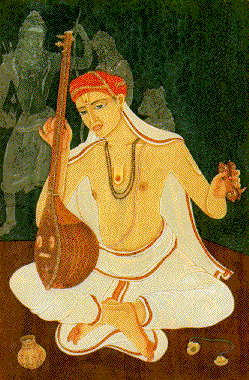
As Printed in Compositions of Tyagaraja by T. K. Govinda Rao


Tyagaraja was born on 27th Caitra, Srvajit, a Sukla Saptami corresponding to 4th May 1767 in Tiruvarur at the residence of his maternal grandfather, Sri Giriraja Kavi who was attached to the Tanjore court. He was the third son of Sri Rama Brahmam and Sitamma, who were then living in a house gifted by Tulajaji of Tanjavur on Tirumanjana Veethi in Tiruvayyaru.
Tyagaraja had his early tutelage under his father, Sri Ramabrahmam, a scholar by his won right and later Sri Ramakrshnananda. It is recorded that Tyagaraja had come under the influence of Saint Narada about whom he acquired a wide knowledge from the palm leaf manuscripts preserved by his grandfather and later, a treatise called 'Svaranava.' The magnitude and the quality of Tyagaraja's later achievements reveal an effort possible only with the blessings of saints like Sri Narada. Hence his compositions: "Narada Guru Swami" in Darbar, "Sri Narada" in Kanada, and "Vara Narada" in VijayaSri extolling Narada are seen as acknowledgment of his gratitude.
At some stage in his early life, Tyagaraja came under the influence of Rama yahna and what followed was a period of undivided devotion to Sri Rama, a movement of tidal proportions in the field of music and spirituality that vies comparison with Ramadasa and Tulasidasa, especially the latter whose picturesque depictions of Sri Rama on the Suvela mountain, Ehi Vidhikrpa Rupa Gunadhama Ram...(Lanka, Doha Ila, Ramacharita Manasa), according to scholars, finds and echo in Tyagaraja's "Giripai Nelakonna" in Sahana and "Paritapamu" in Pratapa Varali, two of his last pieces associated with salvation, where he narrates the experience of the divine presence.
Tyagaraja's fame and the popularity of his songs brought him many disciples. Three branches of his Sishya parampara need specific mention, namely: Umayalpuram, Tillaisthanam and Walajapet, headed by Sundara Bhagavatar and Krshna Bhagavatar, Rama Iyengar, and Valajapet Venkataramana Bhagavatar respectively, who imbibed all that was Tyagaraja and, in turn, propagated his kritis.
An invitation from his far flung disciples and admirers took Tyagaraja on a pilgrimage which extended unto Tirupati where the drawn curtain at the sanctum sanctorum moved him to compose "Tera Tiyagarada" in Gaulipantu. His next move was to the neighborhood of Madras where at the insistence of Kovur Sundara Mudaliar, he visited his village Kovurr and composed five songs on Lord Sundaresa. At Tiruvotiryur, he was drawn by Goddes Tripurasundari to sing five kritis.
A srimukham from the noble sanyasin and Ramabhakta, Upanishad Brahmam took Tyagaraja to Kancipuram where he sang in praise of Lord Varadaraja and Goddess Kamakshi. At Nagapatnam he composed two pieces on Goddess Nilayatakshi.
Tyagaraja's visit to Srirangam is commemorated by five kritis. The next shrine he visited was Lalgudi, known then as Tapastirthapura, where he composed three pieces on Goddess Mahita pravrddha Srimati and two pieces on Saptarshisvara. Besides these kshetra pancaratna kirtanas, Tyagaraja also composed Utsava sampradaya and Divyanama kirtanas and Operas like Nauka caritra and Prahlada bhaktivijaya.
In the final analysis, that music is divine, serving not only as a means but as an end by itself has been the essence and the mission that was Tyagaraja.

Back to the Trinity Homepage
Back to the Main Page